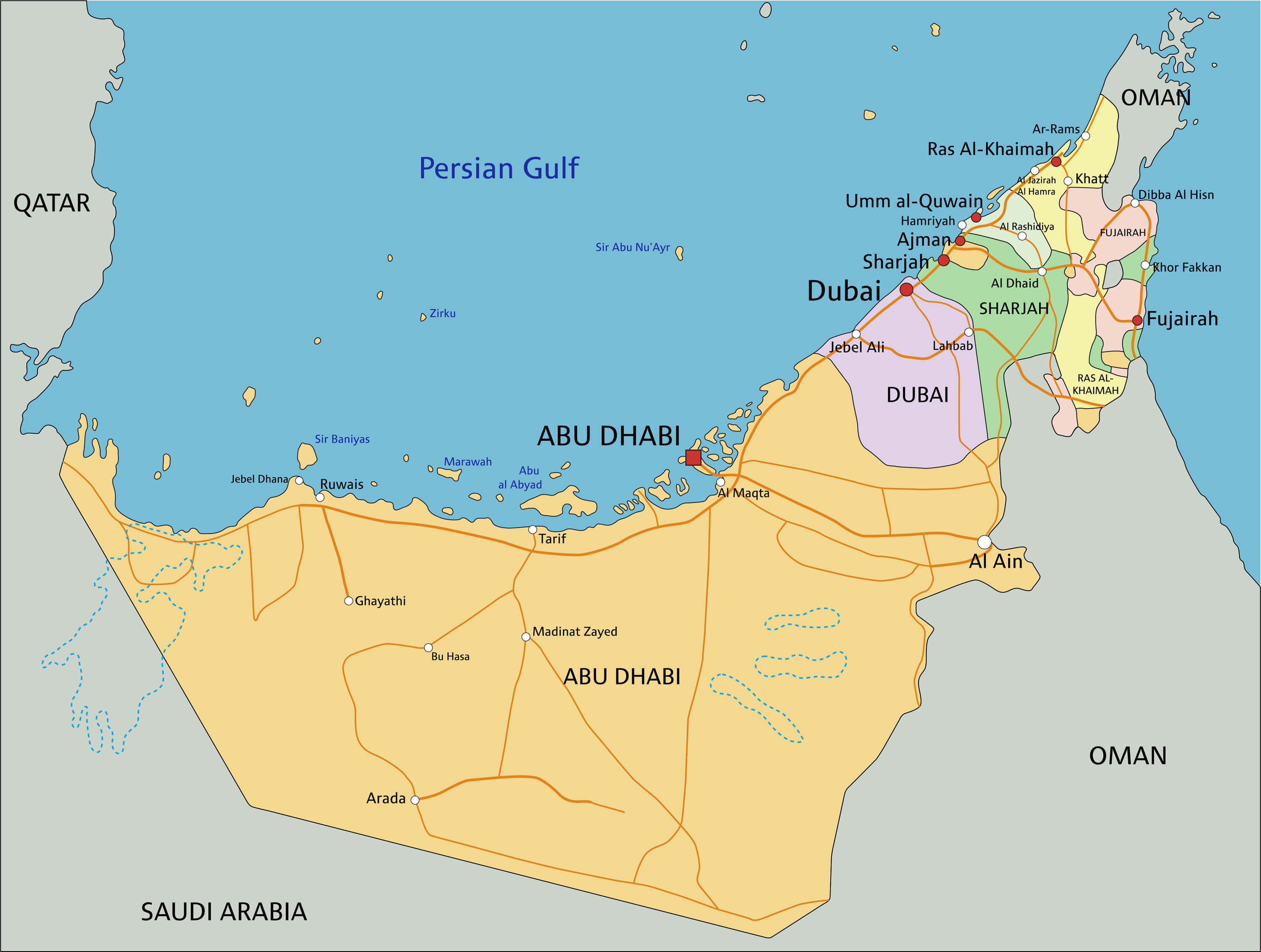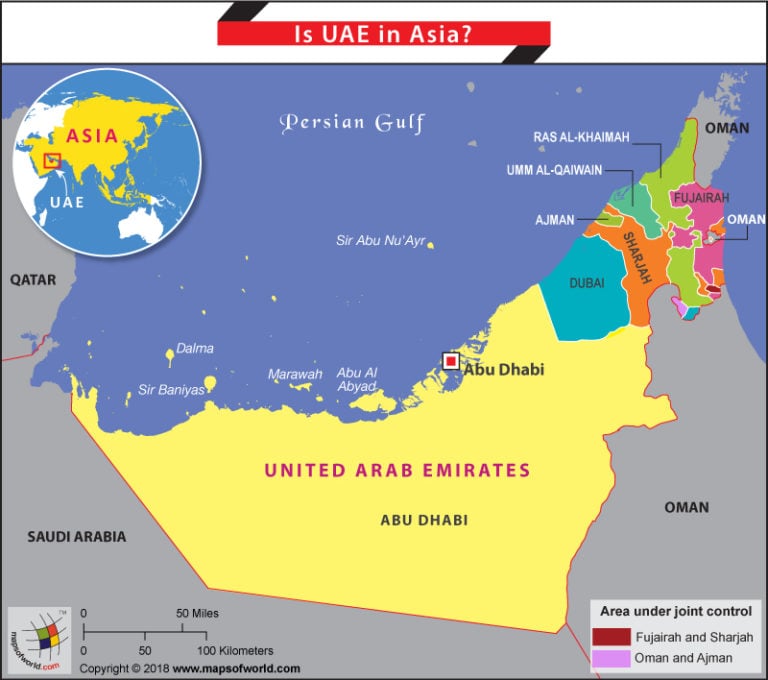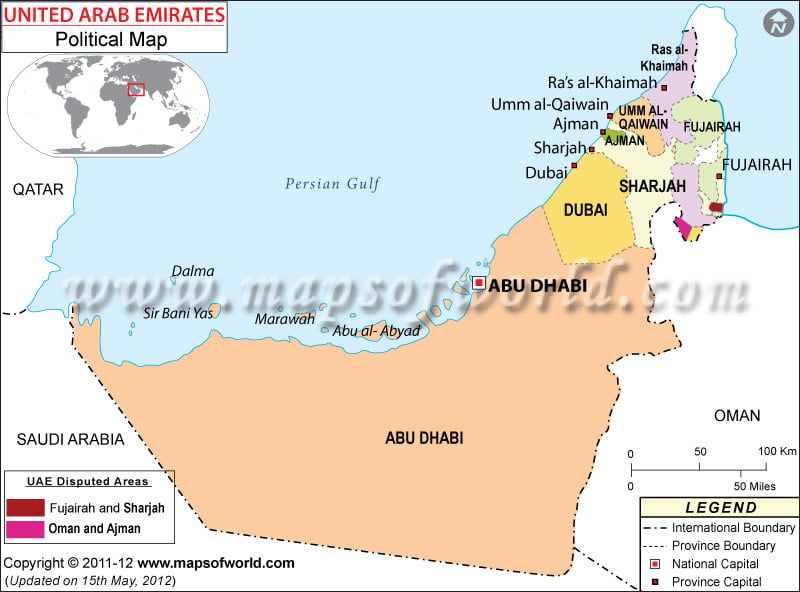Apart from being the capital city, it is also the second largest emirate in the world with an approximate population of 1.6 million people. Abu Dhabi is classified as one of the wealthiest cities in the world with most of its revenue originating from petroleum products. This emirate accounts for approximately two-thirds of the UAE economy. Unlike Dubai which is more Westernized, Abu Dhabi is more into cultural traditions. Islam is the official religion and Arabic is the official language. The United Arab Emirates' oil and natural gas reserves are the world's sixth and seventh-largest, respectively.
Zayed bin Sultan Al Nahyan, ruler of Abu Dhabi and the country's first president, oversaw the development of the Emirates by investing oil revenues into healthcare, education, and infrastructure. The United Arab Emirates has the most diversified economy among the members of the Gulf Cooperation Council. In the 21st century, the country has become less reliant on oil and gas, and is economically focusing on tourism and business.
The government does not levy income tax, although there is a corporate tax in place and a 5% value-added tax was established in 2018. The waters of the UAE, although definitely more cloudy in recent years due to heavy coastal construction, are still, for those from less torrid climes, remarkably warm, clean, and beautiful. There are long stretches of white-sand beaches, ranging from completely undeveloped to highly touristed . The snorkeling and diving can be magnificent, especially along the eastern coast. Vast swaths of desert stretch to the south of the major urban areas, offering dramatic views and terrifying rides in fast-driven safaris. The mountains are dramatic, steep rocky crags, and a visit to them is well rewarded with amazing views.
Women wearing bathing suits will draw unwanted attention at the public beaches; it is advisable to pay for a one-day entry pass to a private beach at a hotel. Ras al-Khaimah is situated to the northern part of the UAE, bordering part of Oman's territory, the Musandam. The population of this emirate is 205,000 people, and the Emirati citizens are the largest group. Ras al-Khaimah does not have any oil, and it has, therefore, focused on advancing its industrial sector. The primary economic areas of Khaimah include real estate, tourism, building materials, service sector, and agriculture.
The most recognized types of attraction in this emirate include shopping, nature, parks, water, and amusement parks. The capital city of this emirate is also referred to as Ras al-Khaimah and it is a home to most of the citizens of Ras al-Khaimah emirate. Dubai is the most populous and the largest emirate in the UAE with approximately 2,502,715 people.
Notably, it is the most progressive emirate among the seven emirates. Dubai is classified as an alpha city due to its strong economy. Despite being a desert, the country has managed to utilize its resources and according to the 2015 statistics, it has an annual GDP of 105.6 billion USD. Unlike its neighboring emirates such as Abu Dhabi, the oil reserves of Dubai have been exhausted; oil contributes only 2 % of the total GDP of this emirate.
Although it started as a port, Dubai has developed into a luxurious emirate that is home to the world's tallest building. Since then, the UAE has been a sovereign nation, enjoying the profits of its natural resources—its reserves of oil and natural gas are the seventh-largest in the world, and it has the seventh-highest GDP per capita. This wealth has turned the Emirates into a major hub of trade, travel, tourism and finance. Dubai's Burj Khalifa, the tallest structure in the world, is emblematic of the Emirates' dramatic construction boom and rise to global prominence. The UAE has developed from a juxtaposition of Bedouin tribes to one of the world's most wealthy states in only about 50 years.
Between 2000 and 2018, average real gross domestic product growth was at close to 4%. It is the second largest economy in the GCC , with a nominal gross domestic product of US$414.2 billion, and a real GDP of 392.8 billion constant 2010 USD in 2018. Since its independence in 1971, the UAE's economy has grown by nearly 231 times to 1.45 trillion AED in 2013.
The non-oil trade has grown to 1.2 trillion AED, a growth by around 28 times from 1981 to 2012. Nowadays the UAE is one of the world's richest countries, with GDP per capita almost 80% higher than OECD average. Human occupation has been traced back to the emergence of anatomically modern humans from Africa some 124,000 BCE through finds at the Faya-2 site in Mleiha, Sharjah. Burial sites dating back to the Neolithic Age and the Bronze Age include the oldest known such inland site at Jebel Buhais. The ensuing Wadi Suq period and three Iron Ages saw the emergence of nomadism as well as the development of water management and irrigation systems supporting human settlement in both the coast and interior.
The Islamic age of the UAE dates back to the expulsion of the Sasanians and the subsequent Battle of Dibba. The UAE' history of trade led to the emergence of Julfar, in the present-day emirate of Ras Al Khaimah, as a regional trading and maritime hub in the area. The maritime dominance of the Persian Gulf by Emirati traders led to conflicts with European powers, including the Portuguese Empire and the British Empire. Much of the work force in the UAE are foreign expatriates - hence the country's population makeup being so diverse, with Emirati citizens being a minority in their own country. All Emirati citizens receive profit sharing cheques from the government and mostly opt to work in the government sector.
Migrant workers from the Indian Subcontinent and the Philippines are mostly employed in the service and construction industries for low wages. Many mid-level jobs are filled by expats and Emirati nationals who work in the private sector, in addition to expats who work in high-skilled and managerial positions and typically enjoy a very good standard of living. If you're interested in working in the UAE there are opportunities in oil and gas, banking, engineering and education. The public school system in Abu Dhabi is hiring a large numbers of English-language teachers from Western countries. These teaching jobs in the UAE are accessible through official recruiters of the Abu Dhabi Education Council. With a total population of 68,000 people, Umm al-Quwain is the least populous state in the UAE.
Unlike the other emirates, Quwain has not made any findings of oil products or gas. Therefore, its economy majorly relies on revenue collected from hotels, tourism, and parks. Despite being the smallest emirate, Ajman is the fourth most populous state in the UAE with about 258,000 people. The major tourist attractions in this area include cultural destinations, hotels, and shopping malls.
The city hosts the Ruler's office, several banks, and approximately fifty local and international retail shops. Ajman was founded in 1803 after Sheik Rashid bin Humaid Al Nuami conquered the coastal settlements. As impressive as economic growth has been in the UAE, the total population has increased from just around 550,000 in 1975 to close to 10 million in 2018. This growth is mainly due to the influx of foreign workers into the country, making the national population a minority. The UAE features a unique labour market system, in which residence in the UAE is conditional on stringent visa rules. This system is a major advantage in terms of macroeconomic stability, as labour supply adjusts quickly to demand throughout economic business cycles.
The Arab states of the Persian Gulf – also known as Gulf countries or the "Arabian Gulf" – is a set of Arab states that border the Persian Gulf. There is a total of seven countries that are part of this region. Almost all of the countries, except Iraq, are members of the Gulf Cooperation Council, a regional intergovernmental union. Iran is also located along the Persian Gulf, but this non-Arab state is not included in the Arabian Gulf. Many of these countries share very similar cultures and values.
From pastime activities such as theater, radio, and soap operas to music styles and a maritime-focused lifestyle, there are many similarities among residents throughout the region. They also have similar economies, bringing in significant revenue from petroleum. However, many nations are becoming less reliant on petroleum and have branched out into other sectors, including banking and tourism.
What Are The 7 Uae Countries Name Dubai may be the second-largest emirate in the country, but it holds the most significant population, the majority of which are ex-pats from around the world. Dubai has a thriving business and tourism industry, having a skyline dotted by majestic buildings and towers. Here, you will find the Burj Al Arab (a 7-star hotel), the Burj Khalifa , and the luxurious Palm Trilogy islands, among many other attractions. Umm al-Quwain is the least populous emirate of the 7 emirates in the UAE, with a total population of 68,000 people. It has not made any discoveries of oil products or coal, as opposed to the other emirates.
Hence its economy relies heavily on revenue from hotels, tourism, and parks. Dubaimay be the second-largest emirate in the country, but it holds the biggest population, majority of which are expats from around the world. Over the years, the country has gone through several key demographic changes. The discovery of oil gave momentum to the economy of the country. Recently, the UAE government has also been promoting a tourism and knowledge-based economy to spur the economic momentum.
Today, Dubai ranks among the most visited cities of the world, ranking 6th with 16 million visitors in 2017, as per thisisinsider.com. The city houses federal government offices and serves as the seat of the UAE Government. Nearly 95% of the oil and 92% of the gas in the country are in this Emirate, making it the wealthiest Emirate.
When considering other entries in the list of city wise population distribution of UAE, Sharjah emerges a distant third from the big two with 1.51 million people. Sharjah's close proximity to Dubai and much lower living costs can be attributed as reasons for its growth. Khaimah's key economic fields include real estate, tourism, construction materials, the utility, and agriculture sectors.
Shopping, nature, parks, water, and amusement parks are among the most recognized kinds of attractions in this emirate. This emirate's capital city is also called Ras al-Khaimah and is home to most Ras al-Khaimah emirate citizens. In terms of land area, Ajmanis the smallest emirate in the UAE.
However, it is the fifth-largest in terms of population, majority of which are expatriates. Initially, fishing was the main industry, but recently there have been rapid developments in business and tourism. When you visit Ajman, don't forget to visit the Ajman National Museum, the Sheikh Zayed Ajman Mosque, and Emirates City.
After joining forces, the UAE has grown to become a significant economic center in the Middle East. This exportation has led to a much-diversified economy making most of the seven emirates such as Dubai to transform into global hubs for retail, finance, and tourism. Annually, each emirate allocates a certain percentage of their revenue to the central budget of the UAE.
The seven emirates have developed differently over the last decade as described below. The UAE's monetary policy stresses stability and predictability, as the Central Bank of the UAE keeps a peg to the US Dollar and moves interest rates close to the Federal Funds Rate. This policy makes sense in the current situation of global and regional economic and geopolitical uncertainty.
In the mid- to long term, however, the peg will become less important, as the UAE transitions to a knowledge-based economy – and becomes yet more independent from the oil and gas sector . Abu Dhabi has an area of 67,340 square kilometres , which is 86.7% of the country's total area, excluding the islands. It has a coastline extending for more than 400 km and is divided for administrative purposes into three major regions. The Emirate of Dubai extends along the Persian Gulf coast of the UAE for approximately 72 km . Dubai has an area of 3,885 square kilometres , which is equivalent to 5% of the country's total area, excluding the islands.
The Emirate of Sharjah extends along approximately 16 km of the UAE's Persian Gulf coastline and for more than 80 km into the interior. The northern emirates which include Fujairah, Ajman, Ras al-Khaimah, and Umm al-Qaiwain all have a total area of 3,881 square kilometres . One is jointly controlled by Oman and Ajman, the other by Fujairah and Sharjah. The UAE coast stretches for nearly 650 km along the southern shore of the Persian Gulf, briefly interrupted by an isolated outcrop of the Sultanate of Oman. Six of the emirates are situated along the Persian Gulf, and the seventh, Fujairah is on the eastern coast of the peninsula with direct access to the Gulf of Oman.
Most of the coast consists of salt pans that extend 8–10 km inland. The largest natural harbor is at Dubai, although other ports have been dredged at Abu Dhabi, Sharjah, and elsewhere. Numerous islands are found in the Persian Gulf, and the ownership of some of them has been the subject of international disputes with both Iran and Qatar. The smaller islands, as well as many coral reefs and shifting sandbars, are a menace to navigation.
Strong tides and occasional windstorms further complicate ship movements near the shore. The UAE also has a stretch of the Al Bāţinah coast of the Gulf of Oman. The Musandam Peninsula, the very tip of Arabia by the Strait of Hormuz, and Madha are exclaves of Oman separated by the UAE. The UAE lies between 22°30' and 26°10' north latitude and between 51° and 56°25′ east longitude. It shares a 530-kilometre border with Saudi Arabia on the west, south, and southeast, and a 450-kilometre border with Oman on the southeast and northeast. The land border with Qatar in the Khawr al Udayd area is about nineteen kilometres in the northwest; however, it is a source of ongoing dispute.
Following Britain's military departure from the UAE in 1971, and its establishment as a new state, the UAE laid claim to islands resulting in disputes with Iran that remain unresolved. The UAE also disputes claim on other islands against the neighboring state of Qatar. The largest emirate, Abu Dhabi, accounts for 87% of the UAE's total area (67,340 square kilometres ). For a long time, it wasn't receiving a lot of attention but this has changed. This emirate is now actively developing the tourism industry with the goal to attract tourists. With each new year, it's just becoming an increasingly popular destination among foreigners.
And the main reason for that is the number of nice hotels and beaches. Saudi Arabia is famous for its well-known city Jeddah and is a world-famous tourist attraction. Saudi is one of the strongest economic countries among its neighbours. The country is famous for oil-based economy and they are the largest exporter of petroleum.
Saudi Arabia owns around 16% of the world's petroleum reserves. Well, one can say that petroleum is one of the products that counts in the economy of the country because it accounts for 87% of all budget revenues with export earnings of 90%. The United Arab Emirates is a federation of seven different emirates, each with its own sheikh. The capitol emirate, Abu Dhabi, covers about 70% of the nation's land. Each emirate retains considerable autonomy, most notably over oil revenues. In theory, the President and Prime Minister are elected by the Supreme Council, which is composed of the sheikhs of each of the seven emirates.






















No comments:
Post a Comment
Note: Only a member of this blog may post a comment.